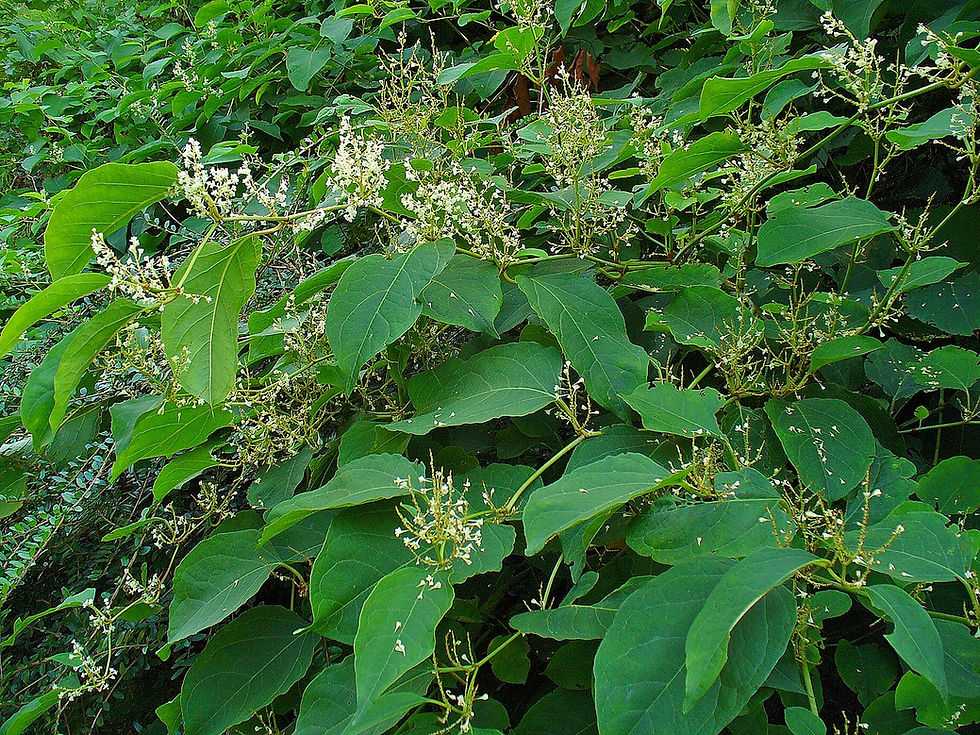A Garden's Menace
- Joanne Lee
- Mar 28, 2021
- 3 min read
By Isabel Cantu
Nobody enjoys having weeds in their garden. They’re a hassle to remove, and if you leave them to grow, you will inevitably end up with a cluttered yard. Generally they do not pose too big a risk and can be kept back with weed killer, but Japanese knotweed is one weed that sparks terror in whoever is unlucky enough to find it sprouting near their home. It is regarded as one of the world’s most invasive species; so invasive that it is illegal to carelessly discard any parts of a knotweed plant since you will inadvertently spawn another cluster. Everywhere except Japan it seems to conquer areas and leave no chance for native plants to thrive. This cockroach of the plant world has a muted response to control methods, extends past ten feet in height, and hungrily invades any and all available space in a matter of weeks. Yet a closer look into the biology of Japanese knotweed has shown that it is not as frightening as it appears to be.

It was originally a lovely ornamental plant, introduced to America and Europe in the late 1800s from Eastern Asia. While Japanese knotweed used to reside in gardens, it is now more commonly found cracking through pavement by roads and dominating land by rivers and streams. There are rarely any homeowners who cherish its presence after seeing its effects on neighboring plants. In Japan it must compete with other tall-growing herbs for space and sunlight—competition it lacks overseas—and is kept in check by different predators. In America and Europe it’s easier for knotweed to invade spaces and splinter through homes and roadsides, and its reproductive methods help it persist. Japanese knotweed has two sexes; female and hermaphrodite. Even though the hermaphroditic plants produce pollen, the Japanese knotweed in America and Britain formed from the same female clone and must reproduce with neighboring male plants to survive, a process that has been quite effective.

Viewing photos of knotweed, their sheer size can make them seem formidable enough, but it is their actions underground that make them a truly unique plant. The leaves and flowers will eventually wilt from winter’s frost, but the rhizomes survive year-round to protect the growing knotweed shoots in spring. The prevalence of Japanese knotweed owes itself to these rhizomes, possibly the root of all complaints against the plant. Rhizomes are the root systems of the Japanese knotweed that not only serve to expand its reach, but also to push its growth. They contain carbohydrates that supply knotweed’s impressive growth spurts and store energy for the plant during cold months. It’s an extremely durable root system; the dwarf variety of Japanese knotweed has rhizomes that can withstand the sulphur dioxide from volcanoes and are commonly found sprouting from volcanic ash.
There is plenty of fear and animosity surrounding Japanese knotweed; there are countless companies making a living off of this fear by inadequately removing the plant from yards and homes. The trick is to attack the durability and persistence of the rhizomes, not simply the above-ground plant. A mix of cutting, herbicides, and introducing other groundcover can help control invasion—no single control method will work alone. It’s also worth noting the seasons in which you apply treatment methods. From late March to mid-April you will see a growth of knotweed stems, and by late May, knotweed is already at its peak height. Once flowering is complete by July, seeds finish maturing in August and September. Following this routine schedule, the most successful treatments involve cutting stems by late August, using herbicides against the rhizomes by winter, and revisiting the knotweed the following year to reapply the treatments. This helps native groundcover grow and compete with any knotweed that’s left, and it’s much more effective than simply mowing down the plant—it attacks the rhizomes themselves, and thus the heart of knotweed’s invasive streak.
Even with the easy-to-hate nature of Japanese knotweed, there is a lot to be admired about it. Not only does it grow by rivers and homes, but on the sides of volcanoes and in industrial rubble. It has the patience to wait several months to begin sprouting in better conditions, and its ability to spread so extensively underground is remarkable. The female clone that was introduced to Britain and America in the 1800s has continued to amaze and horrify us more than two-hundred years later. It is seen as a plant that can never die, a plant that starves all others of light and space: a garden’s ultimate menace.
Works Cited:
Image Credit:
No changes were made: File:Knotweed 1r.jpg - Wikimedia Commons, License: Creative Commons Legal Code No changes were made: Reynoutria japonica - Wikimedia Commons, License: Commons:GNU Free Documentation License, version 1.2 - Wikimedia Commons




Comments